A TaOx-Based RRAM with Improved Uniformity and Excellent Analog Characteristics by Local Dopant Engineering
Abstract
:1. Introduction
2. Materials and Methods
3. Results
3.1. DC I-V Characteristics
3.2. Analog Characteristics
3.3. Mechanism Explanation
4. Conclusions
Author Contributions
Funding
Conflicts of Interest
References
- Yann, L.; Yoshua, B.; Geoffrey, H. Deep learning. Nature 2015, 521, 436–444. [Google Scholar]
- Zheng, Q.; Wang, Z.; Feng, Z.; Yan, B.; Cai, Y.; Huang, R.; Chen, Y.; Yang, C.L.; Li, H.H. Lattice: An ADC/DAC-less Re-RAM-based Processing-In-Memory Architecture for Accelerating Deep Convolution Neural Networks. In Proceedings of the 57th ACM/IEEE Design Automation Conference, San Francisco, CA, USA, 20–24 July 2020; pp. 1–6. [Google Scholar]
- Zhang, W.; Gao, B.; Tang, J.; Yao, P.; Yu, S.; Chang, M.F.; Yoo, H.J.; Qian, H.; Wu, H. Neuro-inspired computing chips. Nat. Electron. 2020, 3, 371–382. [Google Scholar] [CrossRef]
- Zhang, Z.; Wang, Z.; Shi, T.; Bi, C.; Rao, F.; Cai, Y.; Liu, Q.; Wu, H.; Zhou, P. Memory materials and devices: From concept to application. InfoMat 2020, 2, 261–290. [Google Scholar] [CrossRef] [Green Version]
- Bi, G.; Poo, M. Synaptic modifications in cultured hippocampal neurons: Dependence on spike timing, synaptic strength, and postsynaptic cell type. J. Neurosci. 1998, 18, 10464–10472. [Google Scholar] [CrossRef]
- Roy, K.; Jaiswal, A.; Panda, P. Towards spike-based machine intelligence with neuromorphic computing. Nature 2019, 575, 607–617. [Google Scholar] [CrossRef]
- Zheng, Q.; Wang, Z.; Gong, N.; Yu, Z.; Chen, C.; Cai, Y.; Huang, Q.; Jiang, H.; Xia, Q.; Huang, R. Artificial Neural Network Based on Doped HfO2 Ferroelectric Capacitors with Multilevel Characteristics. IEEE Electron Device Lett. 2019, 40, 1309–1312. [Google Scholar] [CrossRef]
- Wang, Z.; Zheng, Q.; Kang, J.; Yu, Z.; Zhong, G.; Ling, Y.; Bao, L.; Bao, S.; Bai, G.; Zheng, S.; et al. Self-Activation Neural Network based on Self-selective Memory Device with Rectified Multilevel States. IEEE Trans. Electron Devices 2020, 67, 4166–4171. [Google Scholar] [CrossRef]
- Upadhyay, N.K.; Jiang, H.; Wang, Z.; Asapu, S.; Xia, Q.; Yang, J.J. Emerging memory devices for neuromorphic computing. Adv. Mater. Technol. 2019, 4, 1800589. [Google Scholar] [CrossRef] [Green Version]
- Yang, J.J.; Strukov, D.B.; Stewart, D.R. Memristive devices for computing. Nat. Nanotechnol. 2013, 8, 13–24. [Google Scholar] [CrossRef]
- Jo, S.H.; Chang, T.; Ebong, I.; Bhadviya, B.B.; Mazumder, P.; Lu, W. Nanoscale memristor device as synapse in neuromorphic systems. Nano Lett. 2010, 10, 1297–1301. [Google Scholar] [CrossRef]
- Yu, M.; Fang, Y.; Wang, Z.; Chen, G.; Pan, Y.; Yang, X.; Yin, M.; Yang, Y.; Li, M.; Cai, Y.; et al. Encapsulation layer design and scalability in encapsulated vertical 3D RRAM. Nanotechnology 2016, 27, 205202. [Google Scholar] [CrossRef]
- Yao, P.; Wu, H.; Gao, B.; Tang, J.; Zhang, Q.; Zhang, W.; Yang, J.J.; Qian, H. Fully hardware-implemented memristor convolutional neural network. Nature 2020, 577, 641–646. [Google Scholar] [CrossRef]
- Yu, Z.; Wang, Z.; Kang, J.; Fang, Y.; Chen, Y.; Cai, Y.; Huang, R. Early-Stage Fluctuation in Low-Power Analog Resistive Memory: Impacts on Neural Network and Mitigation Approach. IEEE Electron Device Lett. 2020, 41, 940–943. [Google Scholar] [CrossRef]
- Ling, Y.; Wang, Z.; Fang, Y.; Kang, J.; Wu, L.; Yang, Y.; Cai, Y.; Huang, R. RTN impacts on RRAM-based Nonvolatile logic circuit. In Proceedings of the IEEE International Conference on Solid-State and Integrated Circuit Technology, Qingdao, China, 31 October–3 November 2018; pp. 1–3. [Google Scholar]
- Kang, J.; Yu, Z.; Wu, L.; Fang, Y.; Wang, Z.; Cai, Y.; Ji, Z.; Zhang, J.; Wang, R.; Yang, Y.; et al. Time-Dependent Variability in RRAM-based Analog Neuromorphic System for Pattern Recognition. In Proceedings of the IEEE International Electron Devices Meeting, San Francisco, CA, USA, 2–6 December 2017; pp. 6.4.1–6.4.4. [Google Scholar]
- Zhao, M.; Gao, B.; Tang, J.; Qian, H.; Wu, H. Reliability of analog resistive switching memory for neuromorphic computing. Appl. Phys. Rev. 2020, 7, 011301. [Google Scholar] [CrossRef]
- Cai, Y.; Wang, Z.; Yu, Z.; Ling, Y.; Chen, Q.; Yang, Y.; Bao, S.; Wu, L.; Bao, L.; Wang, R.; et al. Technology-Array-Algorithm Co-Optimization of RRAM for Storage and Neuromorphic Computing: Device Non-idealities and Thermal Cross-talk. In Proceedings of the IEEE International Electron Devices Meeting, San Francisco, CA, USA, 12–18 December 2020; pp. 13.4.1–13.4.4. [Google Scholar]
- Gao, B.; Zhang, H.W.; Yu, S.; Sun, B.; Liu, L.; Wang, Y.; Han, R.Q.; Kang, J.F.; Yu, B.; Wang, Y.Y. Oxide-based RRAM: Uniformity improvement using a new material-oriented methodology. In Proceedings of the 2009 Symposium on VLSI Technology, Kyoto, Japan, 15–17 June 2009; pp. 30–31. [Google Scholar]
- Liu, Y.; Cai, Y.; Li, Q.; Pan, Y.; Wang, Z.; Huang, R. Inorganic-organic hybrid resistive switching memory with high uniformity and multilevel operation. In Proceedings of the International Symposium on VLSI Technology, Systems and Application, Hsinchu, Taiwan, 28–30 April 2014; pp. 1–2. [Google Scholar]
- Wong, H.S.P.; Lee, H.Y.; Yu, S.; Chen, Y.S.; Wu, Y.; Chen, P.S.; Lee, B.; Chen, F.T.; Tsai, M.J. Metal–oxide RRAM. Proc. IEEE 2012, 100, 1951–1970. [Google Scholar] [CrossRef]
- Li, X.; Zhang, B.; Wang, B.; Xu, X.; Yang, Y.; Sun, S.; Cai, Q.; Hu, S.; An, X.; Li, M.; et al. Low power and high uniformity of HfOx-based RRAM via tip-enhanced electric fields. Sci. China-Inf. Sci. 2019, 10, 1–7. [Google Scholar] [CrossRef] [Green Version]
- Choi, S.; Tan, S.H.; Li, Z.; Kim, Y.; Choi, C.; Chen, P.Y.; Yeon, H.; Yu, S.; Kim, J. SiGe epitaxial memory for neuromorphic computing with reproducible high performance based on engineered dislocations. Nat. Mater. 2018, 17, 335–340. [Google Scholar] [CrossRef]
- Zhang, H.; Liu, L.; Gao, B.; Qiu, Y.; Liu, X.; Lu, J.; Han, R.; Kang, J.; Yu, B. Gd-doping effect on performance of HfO2 based resistive switching memory devices using implantation approach. Appl. Phys. Lett. 2011, 98, 042105. [Google Scholar] [CrossRef]
- Liu, Q.; Long, S.; Wang, W.; Zuo, Q.; Zhang, S.; Chen, J.; Liu, M. Improvement of Resistive Switching Properties in ZrO2-Based ReRAM With Implanted Ti Ions. IEEE Electron Device Lett. 2009, 30, 1335–1337. [Google Scholar] [CrossRef]
- Xie, H.; Liu, Q.; Li, Y.; Lv, H.; Wang, M.; Liu, X.; Sun, H.; Yang, X.; Long, S.; Liu, S.; et al. Nitrogen-induced improvement of resistive switching uniformity in a HfO2-based RRAM device. Semicond. Sci. Technol. 2012, 27, 125008. [Google Scholar] [CrossRef]
- Guan, W.; Long, S.; Liu, Q.; Liu, M.; Wang, W. Nonpolar Nonvolatile Resistive Switching in Cu Doped ZrO2. IEEE Electron Device Lett. 2008, 29, 434–437. [Google Scholar] [CrossRef]
- Duncan, D.; Magyari-Köpe, B.; Nishi, Y. Properties of Dopants in HfOx for Improving the Performance of Nonvolatile Memory. Phys. Rev. Appl. 2017, 7, 034020. [Google Scholar] [CrossRef]
- Fang, Y.; Yu, Z.; Wang, Z.; Zhang, T.; Yang, Y.; Cai, Y.; Huang, R. Improvement of HfOx-Based RRAM Device Variation by Inserting ALD TiN Buffer Layer. IEEE Electron Device Lett. 2018, 39, 819–822. [Google Scholar] [CrossRef]
- Fang, Z.; Yu, H.Y.; Li, X.; Singh, N.; Lo, G.Q.; Kwong, D.L. HfOx/TiOx/HfOx/TiOx Multilayer-Based Forming-Free RRAM Devices with Excellent Uniformity. IEEE Electron Device Lett. 2011, 32, 566–568. [Google Scholar] [CrossRef]
- Sun, Y.; Xu, H.; Wang, C.; Song, B.; Liu, H.; Liu, Q.; Liu, S.; Li, Q. A Ti/AlOx/TaOx/Pt analog synapse for memristive neural network. IEEE Electron Device Lett. 2018, 39, 1298–1301. [Google Scholar] [CrossRef]
- Wang, Z.; Kang, J.; Yu, Z.; Fang, Y.; Ling, Y.; Cai, Y.; Huang, R.; Wang, Y. Modulation of non-linear resistive switching behavior of TaOx-based resistive device through interface engineering. Nanotechnology 2017, 28, 055204. [Google Scholar] [CrossRef]
- Chuang, K.C.; Chu, C.Y.; Zhang, H.X.; Luo, J.D.; Li, W.S.; Li, Y.S.; Cheng, H.C. Impact of the stacking order of HfOx and AlOx dielectric films on RRAM switching mechanisms to behave digital resistive switching and synaptic characteristics. IEEE J. Electron Devices Soc. 2019, 7, 589–595. [Google Scholar] [CrossRef]
- Wang, Z.; Kang, J.; Fang, Y.; Yu, Z.; Yang, X.; Cai, Y.; Wang, Y.; Huang, R. Localized metal doping effect on switching behaviors of TaOx-based RRAM device. In Proceedings of the 16th Non-Volatile Memory Technology Symposium, Pittsburgh, PA, USA, 17–19 October 2016; pp. 1–3. [Google Scholar]
- Xi, Y.; Gao, B.; Tang, J.; Chen, A.; Chang, M.F.; Hu, X.S.; Van Der Spiegel, J.; Qian, H.; Wu, H. In-memory learning with analog resistive switching memory: A review and perspective. Proc. IEEE 2020, 109, 14–42. [Google Scholar] [CrossRef]
- Gao, B.; Wu, H.; Wu, W.; Wang, X.; Yao, P.; Xi, Y.; Zhang, W.; Deng, N.; Huang, P.; Liu, X.; et al. Modeling disorder effect of the oxygen vacancy distribution in filamentary analog RRAM for neuromorphic computing. In Proceedings of the IEEE International Electron Devices Meeting, San Francisco, CA, USA, 2–6 December 2017; pp. 4.4.1–4.4.4. [Google Scholar]
- Wang, Z.; Yin, M.; Zhang, T.; Cai, Y.; Wang, Y.; Yang, Y.; Huang, R. Engineering incremental resistive switching in TaOx based memristors for brain-inspired computing. Nanoscale 2016, 8, 14015–14022. [Google Scholar] [CrossRef]
- Sun, B.; Liu, Y.X.; Liu, L.F.; Xu, N.; Wang, Y.; Liu, X.Y.; Han, R.Q.; Kang, J.F. Highly uniform resistive switching characteristics of TiN/ZrO2/Pt memory devices. J. Appl. Phys. 2009, 105, 061630. [Google Scholar] [CrossRef]
- Fujimoto, M.; Koyama, H.; Konagai, M.; Hosoi, Y.; Ishihara, K.; Ohnishi, S.; Awaya, N. TiO2 anatase nanolayer on TiN thin film exhibiting high-speed bipolar resistive switching. Appl. Phys. Lett. 2006, 89, 223509. [Google Scholar] [CrossRef]
- Yoshida, C.; Tsunoda, K.; Noshiro, H.; Sugiyama, Y. High speed resistive switching in Pt/TiO2/TiN film for nonvolatile memory application. Appl. Phys. Lett. 2007, 91, 223510. [Google Scholar] [CrossRef]
- Sun, C.; Lu, S.M.; Jin, F.; Mo, W.Q.; Song, J.L.; Dong, K.F. Control the switching mode of Pt/HfO2/TiN RRAM devices by tuning the crystalline state of TiN electrode. J. Alloy. Compd. 2018, 749, 481–486. [Google Scholar] [CrossRef]
- Prakash, A.; Deleruyelle, D.; Song, J.; Bocquet, M.; Hwang, H. Resistance controllability and variability improvement in a TaOx-based resistive memory for multilevel storage application. Appl. Phys. Lett. 2015, 106, 233104. [Google Scholar] [CrossRef] [Green Version]
- Kim, K.M.; Lee, S.R.; Kim, S.; Chang, M.; Hwang, C.S. Self-limited switching in Ta2O5/TaOx memristors exhibiting uniform multilevel changes in resistance. Adv. Funct. Mater. 2015, 25, 1527–1534. [Google Scholar] [CrossRef]
- Chen, J.Y.; Huang, C.W.; Chiu, C.H.; Huang, Y.T.; Wu, W.W. Switching kinetic of VCM-based memristor: Evolution and positioning of nanofilament. Adv. Mater. 2015, 27, 5028–5033. [Google Scholar] [CrossRef]
- Lee, M.J.; Lee, C.B.; Lee, D.; Lee, S.R.; Chang, M.; Hur, J.H.; Kim, Y.B.; Kim, C.J.; Seo, D.H.; Seo, S.; et al. A fast, high-endurance and scalable non-volatile memory device made from asymmetric Ta2O5−x/TaO2−x bilayer structures. Nat. Mater. 2011, 10, 625–630. [Google Scholar] [CrossRef]
- Ninomiya, T.; Muraoka, S.; Wei, Z.; Yasuhara, R.; Katayama, K.; Takagi, T. Improvement of Data Retention During Long-Term Use by Suppressing Conductive Filament Expansion in TaOx Bipolar-ReRAM. IEEE Electron Device Lett. 2013, 34, 762–764. [Google Scholar] [CrossRef]
- Wei, Z.; Kanzawa, Y.; Arita, K.; Katoh, Y.; Kawai, K.; Muraoka, S.; Mitani, S.; Fujii, S.; Katayama, K.; Iijima, M.; et al. Highly reliable TaOx ReRAM and direct evidence of redox reaction mechanism. In Proceedings of the IEEE International Electron Devices Meeting, San Francisco, CA, USA, 15–17 December 2008; pp. 1–4. [Google Scholar]
- Wei, Z.; Takagi, T.; Kanzawa, Y.; Katoh, Y.; Ninomiya, T.; Kawai, K.; Muraoka, S.; Mitani, S.; Katayama, K.; Fujii, S.; et al. Demonstration of high-density ReRAM ensuring 10-year retention at 85 C based on a newly developed reliability model. In Proceedings of the IEEE International Electron Devices Meeting, San Francisco, CA, USA, 5–7 December 2011; pp. 31.4.1–31.4.4. [Google Scholar]
- Deng, H.; Cai, Y.; Yu, M.; Huang, R. Formation Energy Study of Oxygen Vacancies in Undoped, Aluminum-Doped and Nitrogen-Doped TaOx-Based RRAM by First Principle Simulation. ECS Trans. 2014, 60, 15. [Google Scholar] [CrossRef]

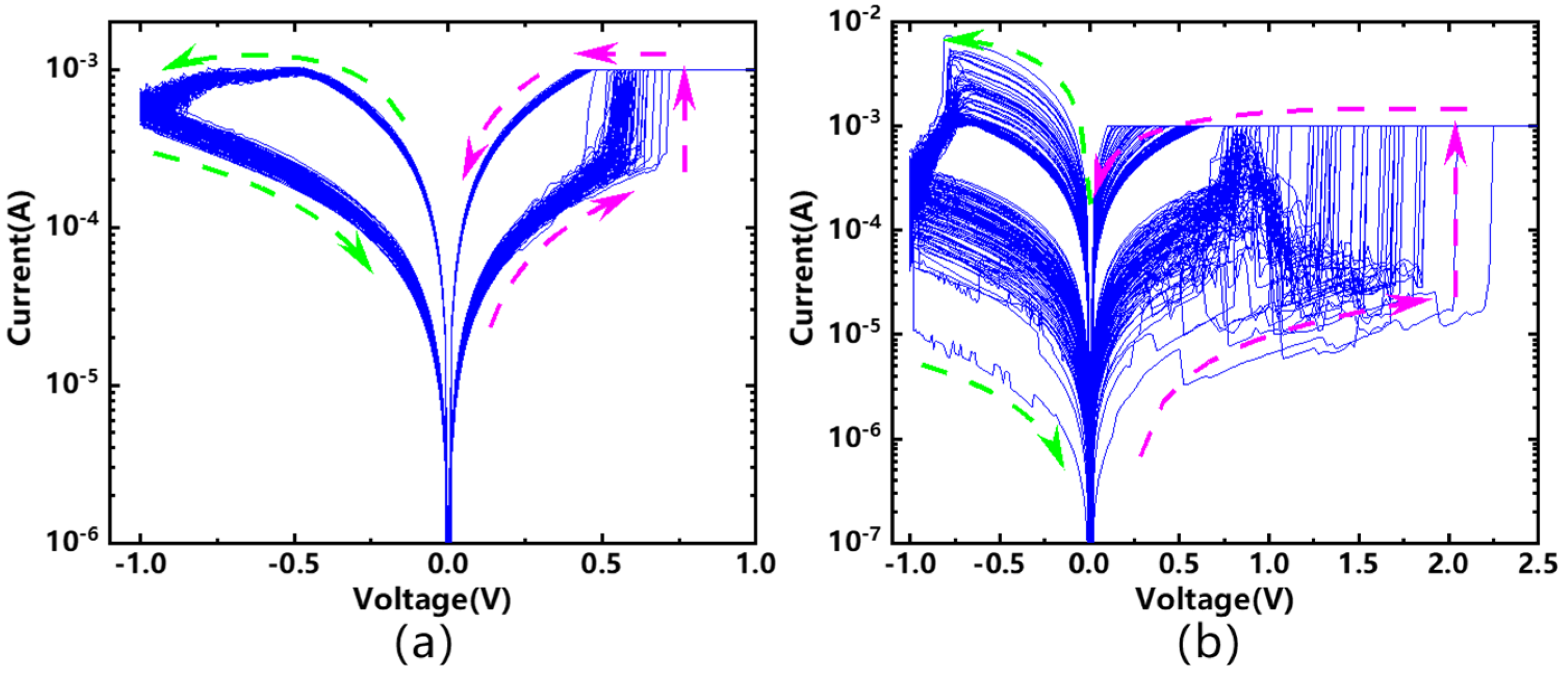
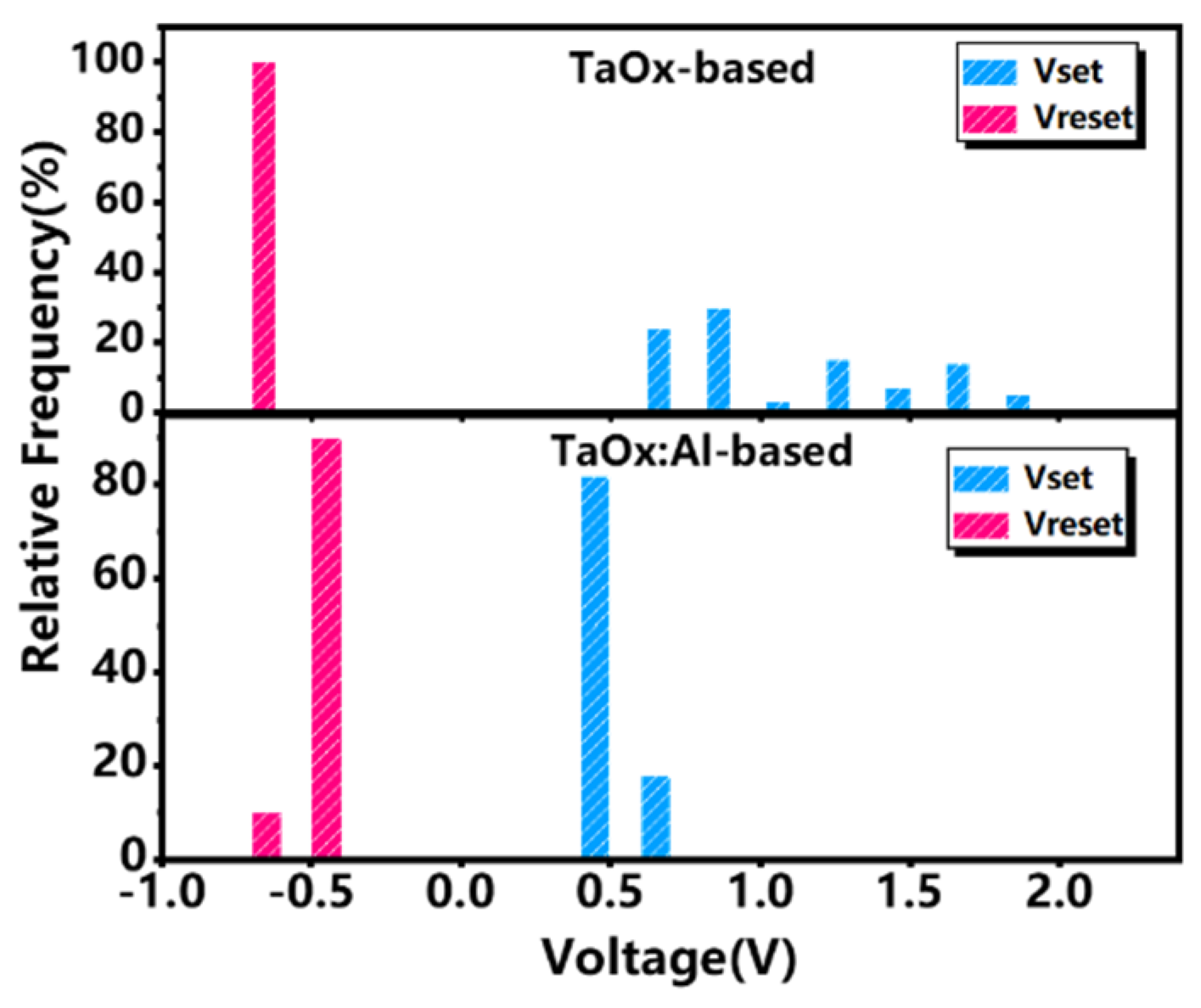

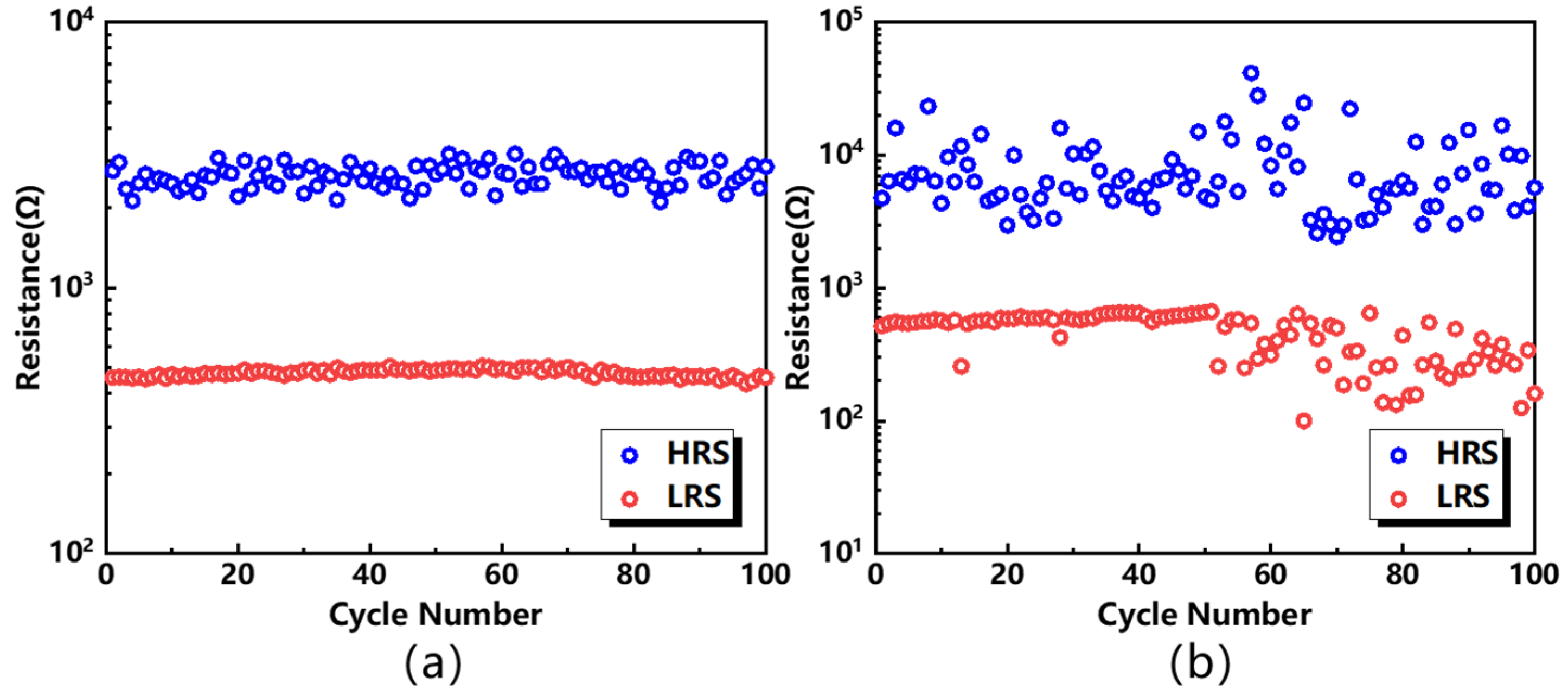
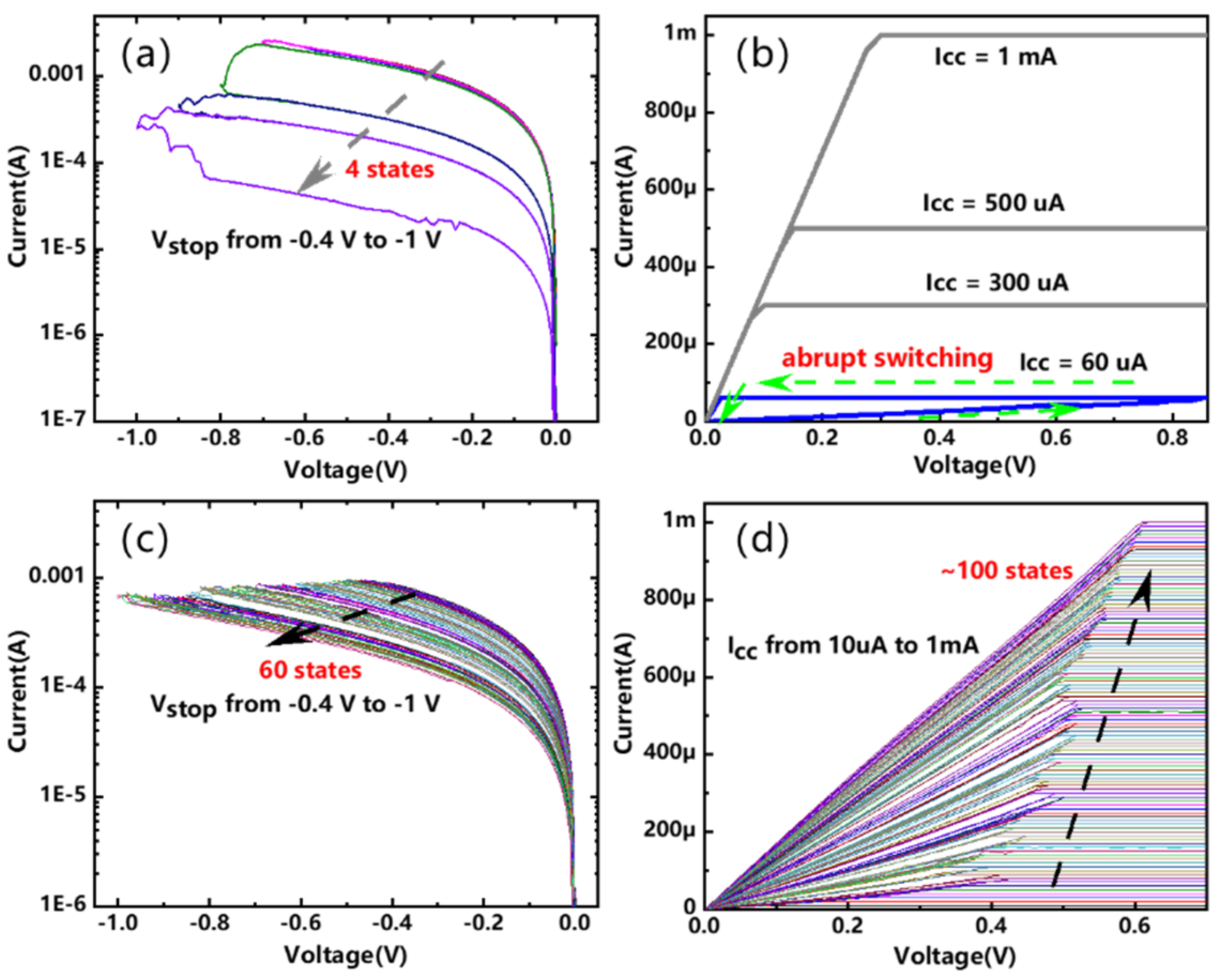
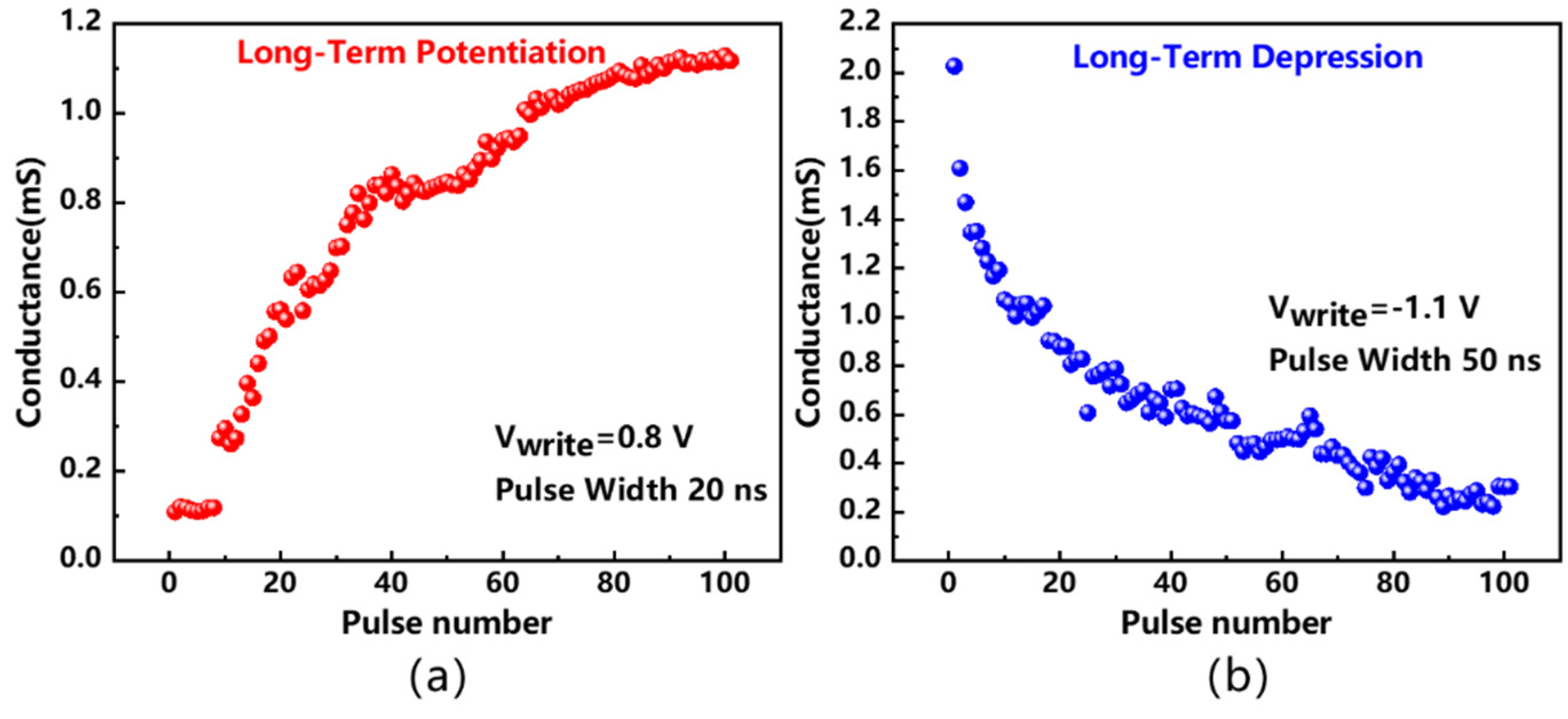

Publisher’s Note: MDPI stays neutral with regard to jurisdictional claims in published maps and institutional affiliations. |
© 2021 by the authors. Licensee MDPI, Basel, Switzerland. This article is an open access article distributed under the terms and conditions of the Creative Commons Attribution (CC BY) license (https://creativecommons.org/licenses/by/4.0/).
Share and Cite
Qin, Y.; Wang, Z.; Ling, Y.; Cai, Y.; Huang, R. A TaOx-Based RRAM with Improved Uniformity and Excellent Analog Characteristics by Local Dopant Engineering. Electronics 2021, 10, 2451. https://doi.org/10.3390/electronics10202451
Qin Y, Wang Z, Ling Y, Cai Y, Huang R. A TaOx-Based RRAM with Improved Uniformity and Excellent Analog Characteristics by Local Dopant Engineering. Electronics. 2021; 10(20):2451. https://doi.org/10.3390/electronics10202451
Chicago/Turabian StyleQin, Yabo, Zongwei Wang, Yaotian Ling, Yimao Cai, and Ru Huang. 2021. "A TaOx-Based RRAM with Improved Uniformity and Excellent Analog Characteristics by Local Dopant Engineering" Electronics 10, no. 20: 2451. https://doi.org/10.3390/electronics10202451
APA StyleQin, Y., Wang, Z., Ling, Y., Cai, Y., & Huang, R. (2021). A TaOx-Based RRAM with Improved Uniformity and Excellent Analog Characteristics by Local Dopant Engineering. Electronics, 10(20), 2451. https://doi.org/10.3390/electronics10202451




